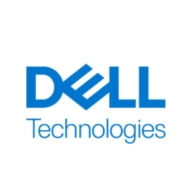

VxRail and Azure Stack HCI compete in the hyper-converged infrastructure market. VxRail is favored for deployment ease and customer support, while Azure Stack HCI shines with its robust feature set, appealing to users valuing extensive functionality.
Features: VxRail integrates seamlessly with VMware environments, offers advanced automation, and provides efficient lifecycle management. It supports high performance and centralized management, making it suitable for VMware users. Azure Stack HCI, on the other hand, aligns well with Microsoft Azure services, providing powerful hybrid cloud capabilities, flexibility in service integration, and support for containerized applications with Azure Kubernetes Service (AKS).
Room for Improvement: VxRail could enhance its scalability options and reduce initial deployment complexity for those needing extensive customization. It also requires better support for non-VMware ecosystems. Azure Stack HCI can improve deployment simplicity and reduce its reliance on comprehensive Microsoft ecosystem knowledge. It should streamline integration processes for less technical users and enhance its customer interface design.
Ease of Deployment and Customer Service: VxRail is praised for straightforward deployments and responsive customer service, making it ideal for quick implementations and easy troubleshooting. It simplifies lifecycle management through VxRail Manager. Azure Stack HCI, while reliable, involves more complexity due to extensive service features and requires familiarity with Microsoft's ecosystem, though its support remains robust.
Pricing and ROI: VxRail has a higher initial setup cost but offers quick returns with minimal management overhead and faster deployment times, attracting organizations needing immediate value. Azure Stack HCI presents a more flexible pricing model reflecting Azure services, benefiting hybrid environments. Its ROI is more pronounced with prolonged Azure integration, catering to long-term strategies centered on cloud adaptation.
There has been some return on investment in terms of just time usability and reduction of footprint.
Not every support team member is very knowledgeable about Azure Stack HCI, creating delays in resolution.
A key area for improvement for VMware would be response time.
The support is all provided by Dell, and it is quite good.
There are limitations, such as the inability to upgrade from a single to dual CPU in certain configurations.
Scalability is easy with VxRail.
It does not feel like a well-oiled machine yet, with too many idiosyncrasies and insufficient documentation and integration, feeling more like software that is still in beta.
It is a very stable and mature product, with centralized management and upgrades being perfect for us.
The product is very stable, and I rate its stability as nine out of ten.
There are discrepancies between managing VMs through Azure Arc versus managing them directly, as changes made not using the Azure Arc integration are not easily reflected in Azure Arc.
Hyper V seems to lag behind compared to VMware.
It requires a very clean environment to proceed without issues.
Stabilizing the update procedure further would make it better.
The major issue with VxRail is the razoring process, which can only be performed by Dell.
The licensing is quite expensive because it's per call.
Previously, the cost was higher, however, recent changes in VMware pricing have reduced it.
Purchasing VxRail is quite expensive compared to a simple Dell server.
The cost varies for us as a large company because we receive special offers from Dell.
The integration with Azure using Azure Arc is excellent.
Customers prefer the single pane of glass management and integration with VMware, which makes it easier for them to proceed with decisions involving VMware products.
The most valuable feature of VxRail is the VxRail Manager, which centralizes resources like storage built with vSAN.
The features of VxRail that we find most useful for our customers include the easy update mechanism and the support for both VMware and hardware.
| Product | Market Share (%) |
|---|---|
| VxRail | 15.8% |
| Azure Stack HCI | 3.7% |
| Other | 80.5% |


| Company Size | Count |
|---|---|
| Small Business | 4 |
| Midsize Enterprise | 1 |
| Large Enterprise | 2 |
| Company Size | Count |
|---|---|
| Small Business | 41 |
| Midsize Enterprise | 42 |
| Large Enterprise | 56 |
Azure Stack HCI efficiently integrates software-defined networking and Azure Kubernetes Service, offering a streamlined hybrid setup for VM management while maintaining top performance.
Azure Stack HCI enhances data center operations with high-end processors and storage, optimal Kubernetes support, and integration with Azure Arc and Azure Site Recovery. High application density in four-node configurations improves both time and infrastructure efficiency. Despite its strengths, the platform can improve in areas like software-defined networking, operational management, and simplifying deployments, which currently rely on PowerShell. Users often desire better training and integration with Microsoft Azure Portal, along with multi-cluster capabilities and storage architecture enhancements. Improvements in Hyper V virtualization are also needed to match competitors like VMware.
What are the key features of Azure Stack HCI?In sectors like government, Azure Stack HCI is crucial for running secure on-premise services with selectable Azure features to ensure data privacy. Businesses leverage the platform for VM creation, management, and monitoring through Windows Center, alongside Kubernetes production environments. Connectivity with Azure allows for smoother cloud transitions, appreciated for its dashboard manageability and substantial network capacity.
VxRail is a hyper-converged infrastructure appliance co-engineered by Dell Technologies and VMware, designed to optimize VMware environments by simplifying compute, storage, virtualization, and management.
Built on VMware vSAN software, VxRail ensures high performance, reliability, and flexibility. It supports a broad array of workloads, from business-critical applications to next-generation use cases. VxRail simplifies infrastructure management with powerful integration and seamless scalability, offering centralized management and user-friendly interfaces. Streamlined updates, robust lifecycle management, and one-click upgrades facilitate a user-centric experience that minimizes deployment complexity and staffing needs. However, its performance with disk deduplication, integration with public clouds, and processor support can be enhanced, along with pricing and licensing improvements.
What features define VxRail?Organizations across sectors such as finance, telecommunications, education, and manufacturing utilize VxRail for its scalability, ease of deployment, and infrastructure management capabilities. It aids in server and application hosting, storage, and virtualization management, often employing VMware integration. The platform is valued for its ability to consolidate IT components, support VDI solutions, and enhance cloud readiness and resource allocation.
We monitor all HCI reviews to prevent fraudulent reviews and keep review quality high. We do not post reviews by company employees or direct competitors. We validate each review for authenticity via cross-reference with LinkedIn, and personal follow-up with the reviewer when necessary.